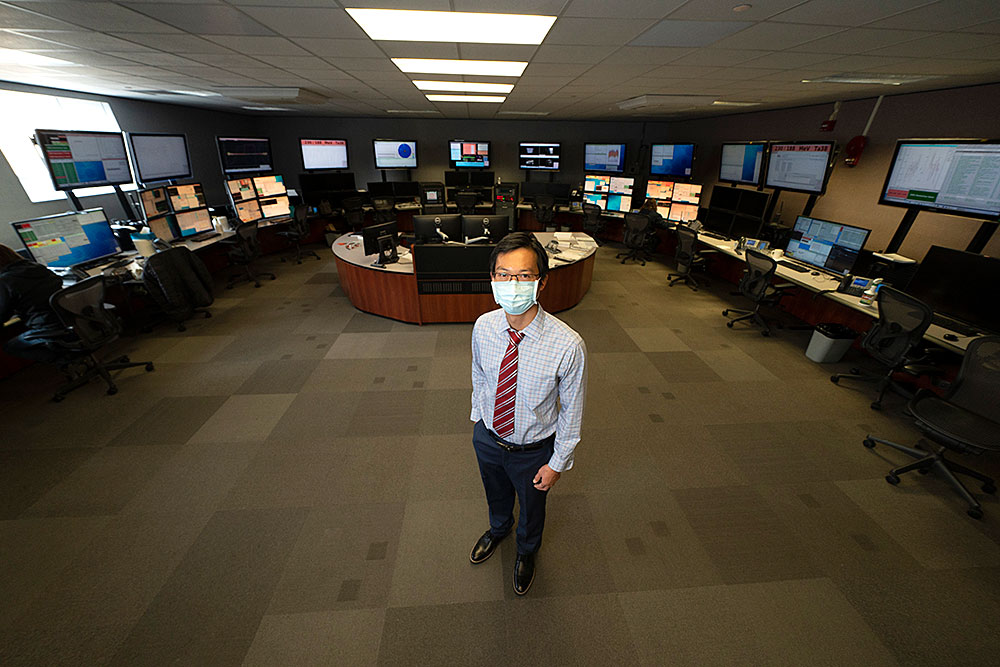“Run 21 is the final step of Beam Energy Scan II (BES-II), a three-year systematic study of what happens when gold ions—gold atoms stripped of their electrons—collide at various low energies,” said Brookhaven physicist Lijuan Ruan, co-spokesperson for RHIC’s STAR experiment collaboration.
Nuclear physicists will examine the BES-II data, along with data from RHIC’s high-energy collisions, to map out how these collisions transform ordinary protons and neutrons into an extraordinary soup of free quarks and gluons—a substance that mimics what the early universe was like some 14 billion years ago. By turning the collision energy down, RHIC physicists can change the temperature and other variables to study how these conditions affect the transition from ordinary matter to early-universe hot quark-and-gluon soup.
“Out of the five energies of BES-II—9.8, 7.3, 5.75, 4.6, and 3.85 billion electron volts, or GeV—this year’s run at 3.85 GeV is the most difficult one,” said Brookhaven Lab accelerator physicist Chuyu Liu, the run coordinator. That’s because “RHIC’s beams of gold ions are really difficult to hold together at the lowest energy,” he explained.
In Run 21, the accelerator team will use a variety of innovative components and schemes to maintain the lifetime and intensity of the colliding ion beams under challenging conditions. Read on to learn more about RHIC’s Run 21 science goals and the accelerator features that will make the science possible.
Scanning the transition
As Ruan explained, the quest to map out the phases of nuclear matter and the transitions between them is somewhat similar to studying how water molecules transform from solid ice to liquid water and gaseous steam at different temperatures and pressures. But nuclear matter is trickier to study.
“We need a powerful particle collider and sophisticated detector systems to create and study the most extreme forms of nuclear matter,” she said. “Thanks to the incredible versatility of RHIC, we can use the ‘knob’ of collision energy and the intricate particle-tracking capabilities of the STAR detector to conduct this systematic study.”
RHIC’s highest collision energies (up to 200 GeV) produce temperatures more than 250,000 times hotter than the center of the Sun. Those collisions “melt” the protons and neutrons that make up gold atoms’ nuclei, creating an exotic phase of nuclear matter called a quark-gluon plasma (QGP). In QGP, quarks and gluons are “free” from their ordinary confinement within protons and neutrons, and they flow with virtually no resistance—like a nearly perfect liquid.
But QGP lasts a mere fraction of a second before “freezing out” to form new particles. RHIC physicists piece together details of how the melting and refreezing happen by taking “snapshots” of the particles that stream out of these collisions.
By systematically lowering the collision energy, the physicists are looking for signs of a so-called “critical point.” This would be a set of conditions where the type of transition between ordinary nuclear matter and QGP changes from the smooth crossover observed at RHIC’s highest energies (picture butter melting gradually on a counter), to an abrupt “first order” phase change (think of how water boils suddenly at a certain temperature and holds that temperature until all the molecules evaporate).
“Theorists have predicted that certain key measurements at RHIC will exhibit dramatic event-by-event fluctuations when we approach this critical point,” Ruan said.
Some RHIC physicists liken these fluctuations to the turbulence an airplane experiences when it moves from smooth air into a bank of clouds and then back out again. Measurements from phase I of RHIC’s Beam Energy Scan (BES-I, with data collected between 2010 and 2017) revealed tantalizing hints of such turbulence. But because collisions are hard to achieve at low energies, the data from BES-I aren’t strong enough to draw definitive conclusions.
Now, in BES-II, a host of accelerator improvements have been implemented to maximize low-energy collision rates.
Cooling the ions
One of the innovations that Chuyu Liu and the other Collider-Accelerator Department (C-AD) physicists managing RHIC operations will take advantage of in Run 21 is a first-of-its-kind beam-cooling system. This Low Energy RHIC electron Cooling (LEReC) system operated at full capacity for the first time in last year’s RHIC run, making it the world’s first implementation of electron cooling in a collider. But it will be even more important for the lowest-of-low collision energies this year.
“The longer the beam stays at low energy, the more ‘intra-beam scattering’ and ‘space charge’ effects degrade the beam quality, reducing the number of circulating ions,” said Liu. Simplistic translation: The positively charged ions tend to repel one another. (Remember: The ions are atoms of gold stripped of their electrons, leaving a lot of net positive charge from the 79 protons in the nucleus.) The scattering and the repulsive space charge cause the ions to spread out, essentially heating up the beam as it makes its way around the 2.4-mile-circumference RHIC accelerator. And spread-out ions are less likely to collide.
“The LEReC system operates somewhat similar to the way the liquid running through your home refrigerator extracts heat to keep your food cool,” said Wolfram Fischer, Associate Chair for Accelerators in C-AD, “but the technology needed to achieve this beam cooling is quite a bit more complicated.”
A series of components (special lasers and a photocathode gun) produces bunches of relatively cool electrons, which are accelerated to match the bunching and near-light-speed pace of RHIC’s ions. Transfer lines inject the cool electrons into the stream of ion bunches—first in one RHIC ring, then, after making a 180-degree turn, into the other. As the particles mix, the electrons extract heat, effectively squeezing the spread-out ion bunches back together. The warmed-up electron bunches then get dumped and replaced with a new cool batch.
“To add more flexibility for cooling optimization during this year’s run at RHIC’s lowest energy, where the space-charge effects and beam lifetime degradation are concerns for both the electrons and the ions, we installed a new ‘second harmonic’ radiofrequency (RF) cavity in the electron accelerator,” said Alexei Fedotov, the accelerator physicist who led the LEReC project.
These cavities generate the radio waves that push the electrons along their path, with the higher (second harmonic) frequency helping to flatten out the longitudinal profile of the electron bunches. “This should help to reduce the space charge effect in the electron beams to achieve better cooling performance at low energy,” Fedotov said.
“We plan to commission the new electron beam transport line in late January and start cooling ions with the new electron beam setup in early February,” he added.
More accelerator advances
Similarly, third-harmonic RF cavities installed in the ion accelerator rings will help to flatten the longitudinal profile of the ion bunches, reducing their peak intensity and space charges, Liu explained. “With that, more bunch intensity can be injected into RHIC to produce higher luminosity—a measure closely tied to collision rates,” he said.
The accelerator team will also be commissioning a new bunch-by-bunch feedback system to help stabilize the beam for a better lifetime. “This system measures how each ion bunch deviates from the center of the beam pipe, and then applies a proportional correction signal through a component called a kicker to nudge each bunch back to where it should be,” Liu said.
All this cooling and nudging will counteract the ions’ tendency to spread, which maximizes chances of collisions happening when the two beams cross at the center of STAR.
“This run will bring together many of the advances we’ve been working on at RHIC to meet the challenging conditions of low-energy collisions,” said Fischer. “STAR would have preferred to test the lowest energy first, but we needed to learn everything possible (and develop the electron cooling system) before we could embark on operation at the most difficult energy.”
RHIC operations are funded by the DOE Office of Science.
Brookhaven National Laboratory is supported by the U.S. Department of Energy’s Office of Science. The Office of Science is the single largest supporter of basic research in the physical sciences in the United States and is working to address some of the most pressing challenges of our time. For more information, visit https://www.energy.gov/science/.
Follow @BrookhavenLab on Twitter or find us on Facebook.



